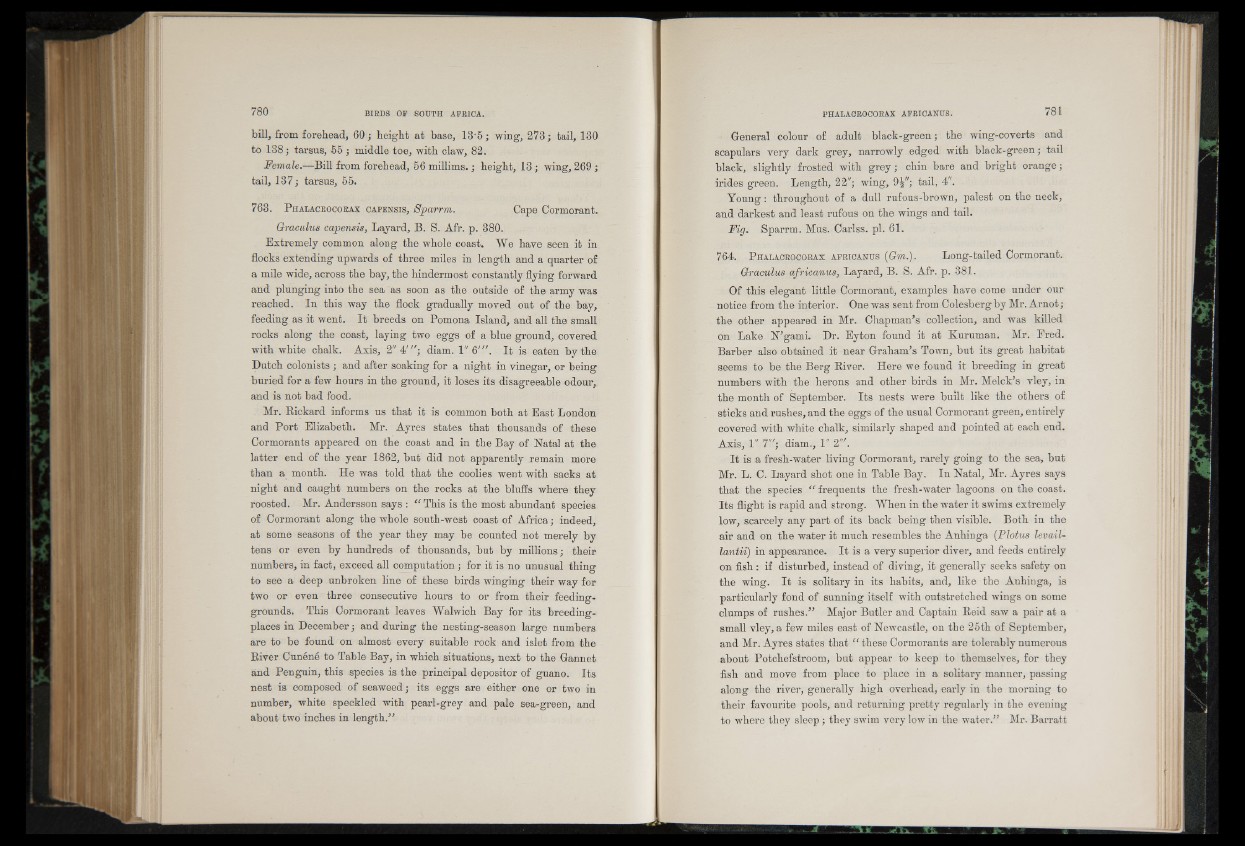
bill, from forehead, 60; height at base, 13*5 j wing, 273; tail, 130
to 138; tarsus, 55 ; middle toe, with claw, 82.
Female.—Bill from forehead, 56 millims.; height, 13; wing, 269;
tail, 137; tarsus, 55.
763. P halacrocorax capensis, Sp cvrr vn. Cape Cormorant.
Oraculus capensis, Layard, B. S. Afr. p. 380.
Extremely common along the whole coast. We have seen it in
flocks extending upwards of three miles in length and a quarter of
a mile wide, across the bay, the hindermost constantly flying forward
and plunging into the sea as soon as the outside of the army was
reached. In this way the flock gradually moved out of the bay,
feeding as it went. It breeds on Pomona Island, and all the small
rocks along the coast, laying two eggs of a blue ground, covered
with white chalk. Axis, 2" 4'"; diam. 1" 6'" . It is eaten by the
Dutch colonists ; and after soaking for a night in vinegar, or being
buried for a few hours in the ground, it loses its disagreeable odour,
and is not bad food.
Mr. Rickard informs us that it is common both at East London
and Port Elizabeth. Mr. Ayres states that thousands of these
Cormorants appeared on the coast and in the Bay of Natal at the
latter end of the year 1862, but did not apparently remain more
than a month. He was told that the coolies went with sacks at
night and caught numbers on the rocks at the bluffs where they
roosted. Mr. Andersson says : “ This is the most abundant species
of Cormorant along the whole south-west coast of Africa; indeed,
at some seasons of the year they may be counted not merely by
tens or even by hundreds of thousands, but by millions; their
numbers, in fact, exceed all computation ; for it is no unusual thing
to see a deep unbroken line of these birds winging their way for
two or even three consecutive hours to or from their feeding-
grounds. This Cormorant leaves Walwich Bay for its breeding-
places in December; and during the nesting-season large numbers
are to be found on almost every suitable rock and islet from the
River Cunene to Table Bay, in which situations, next to the Gannet
and Penguin, this species is the principal depositor of guano. Its
nest is composed of seaweed; its eggs are either one or two in
number, white speckled with pearl-grey and pale sea-green, and
about two inches in length.”
General colour of adult black-green; the wing-coverts and
scapulars very dark grey, narrowly edged with black-green; tail
black, slightly frosted with grey; chin bare and bright orange;
irides green. Length, 22"; wing, 9|"; tail, 4".
Young: throughout of a dull rufous-brown, palest on the neck,
and darkest and least rufous on the wings and tail.
Fig. Sparrm. Mus. Carlss. pi. 61.
764. P halacrocorax africanus (Gm.). Long-tailed Cormorant.
Oraculus africanus., Layard, B. S. Afr. p. 381.
Of this elegant little Cormorant, examples have come under our
notice from the interior. One was sent from Colesberg by Mr. Arnot;
the other appeared in Mr. Chapman'’s collection, and was killed
on Lake N’gami. Dr. Eyton found it at Kuruman. Mr. Ered.
Barber also obtained it near Graham’s Town, but its great habitat
seems to be the Berg River. Here we found it breeding in great
numbers with the herons and other birds in Mr. Melck’s vley, in
the month of September. Its nests were built like the others of
sticks and rushes, and the eggs of the usual Cormorant green, entirely
covered with white chalk, similarly shaped and pointed at each end.
Axis, 1" 7'"; diam., 1" 2'".
It is a fresh-water living Cormorant, rarely going to the sea, but
Mr. L. C. Layard shot one in Table Bay. In Natal, Mr. Ayres says
that the species “ frequents the fresh-water lagoons on the coast.
Its flight is rapid and strong. When in the water it swims extremely
low, scarcely any part of its back being then visible. Both in the
air and on the water it much resembles the Anhinga (Plotus levail-
lantii) in appearance. It is a very superior diver, and feeds entirely
on fish: if disturbed, instead of diving, it generally seeks safety on
the wing. It is solitary in its habits, and, like the Anhinga, is
particularly fond of sunning itself with outstretched wings on some
clumps of rushes.” Major Butler and Captain Reid saw a pair at a
small vley, a few miles east of Newcastle, on the 25th of September,
and Mr. Ayres states that “ these Cormorants are tolerably numerous
about Potchefstroom, but appear to keep to themselves, for they
fish and move from place to place in a solitary manner, passing
along the river, generally high overhead, early in the morning to
their favourite pools, and returning pretty regularly in the evening
to where they sleep; they swim very low in the water.” Mr. Barratt